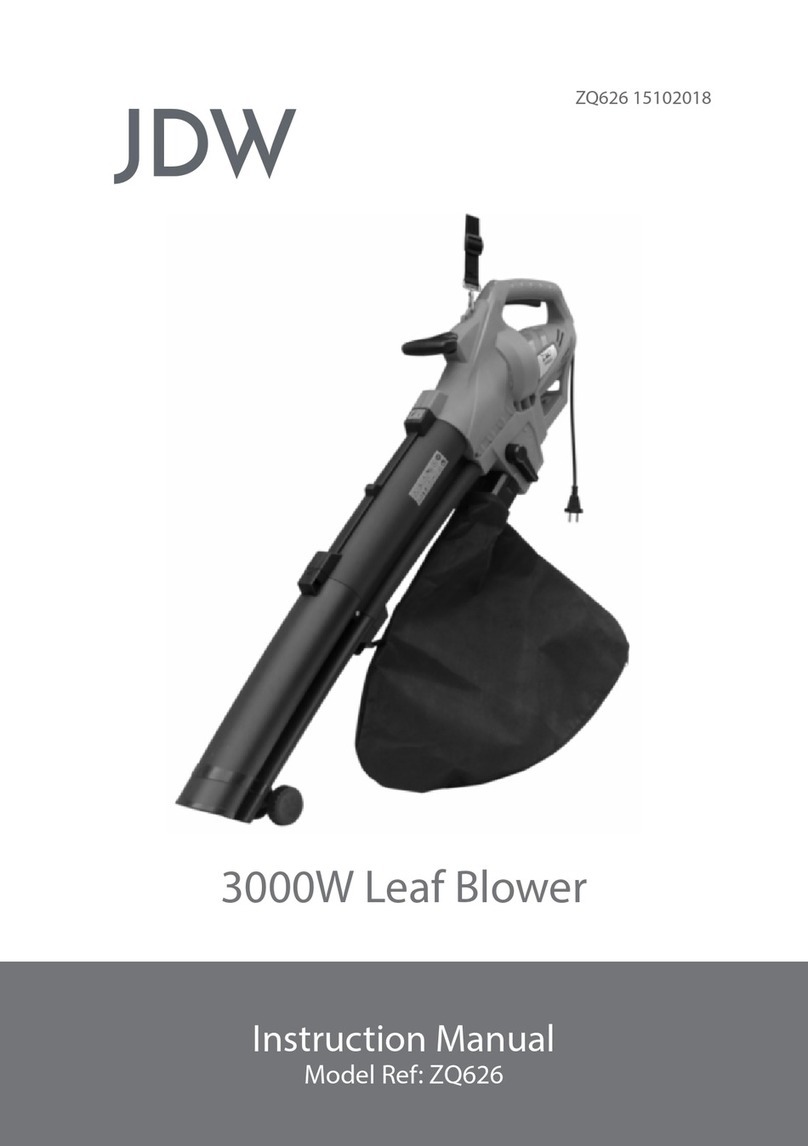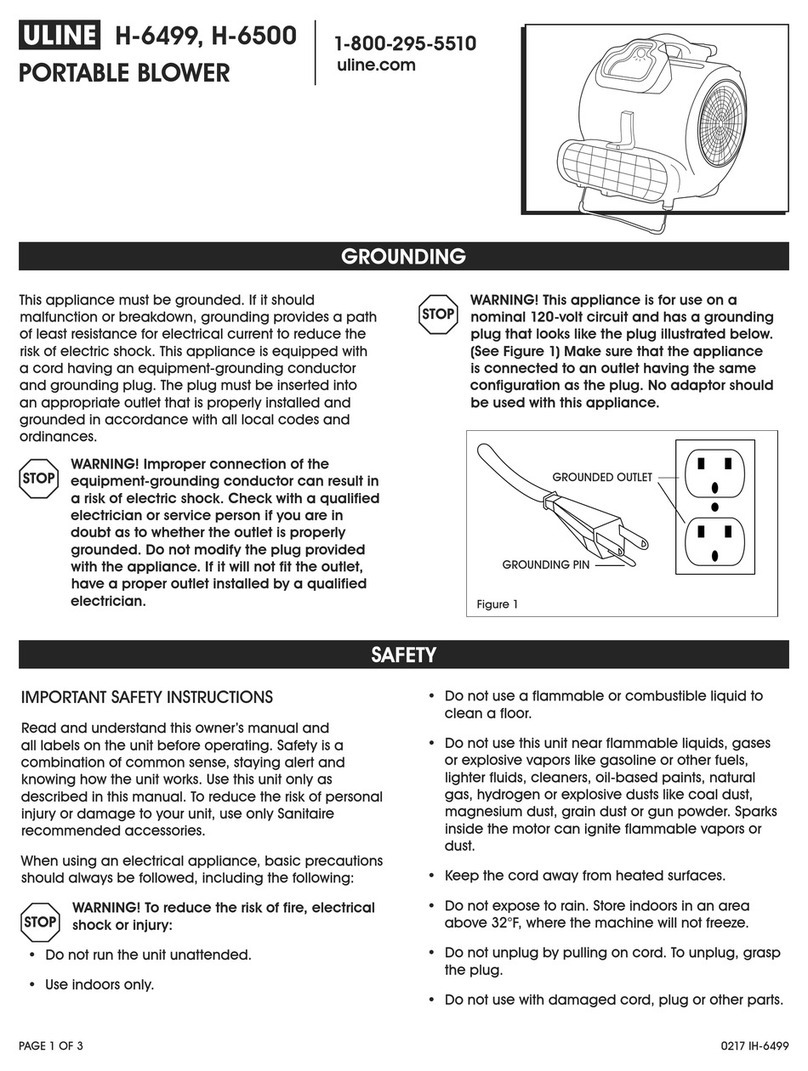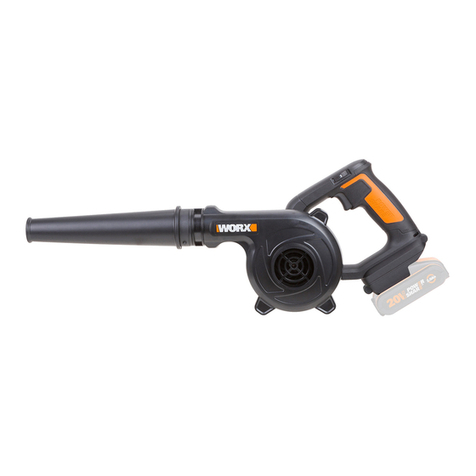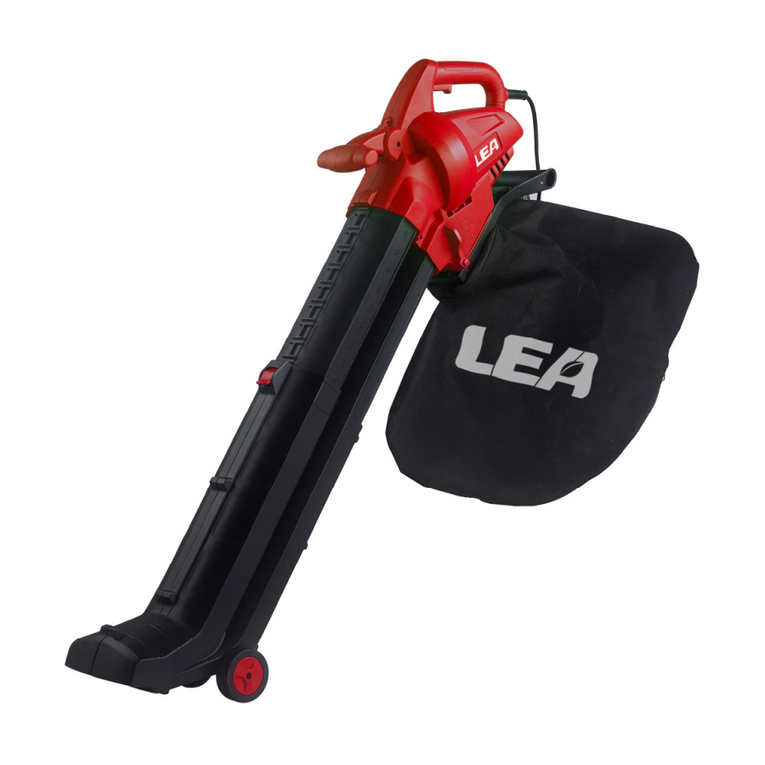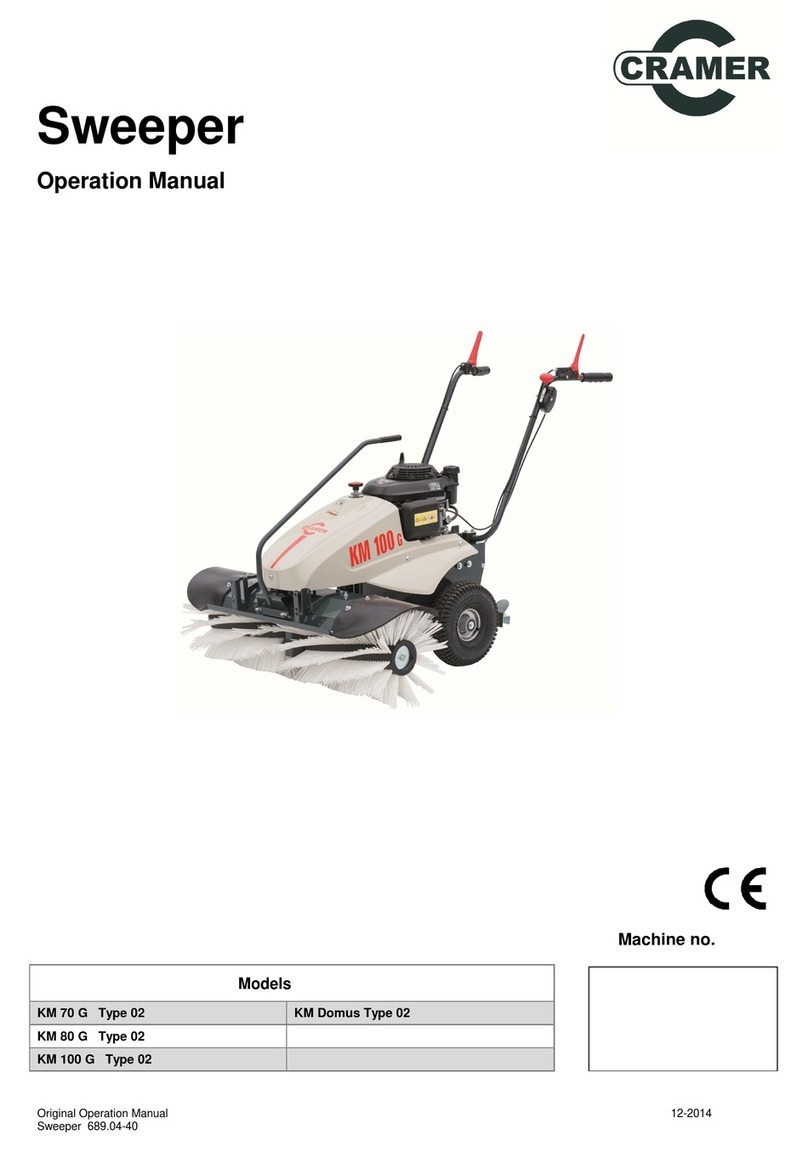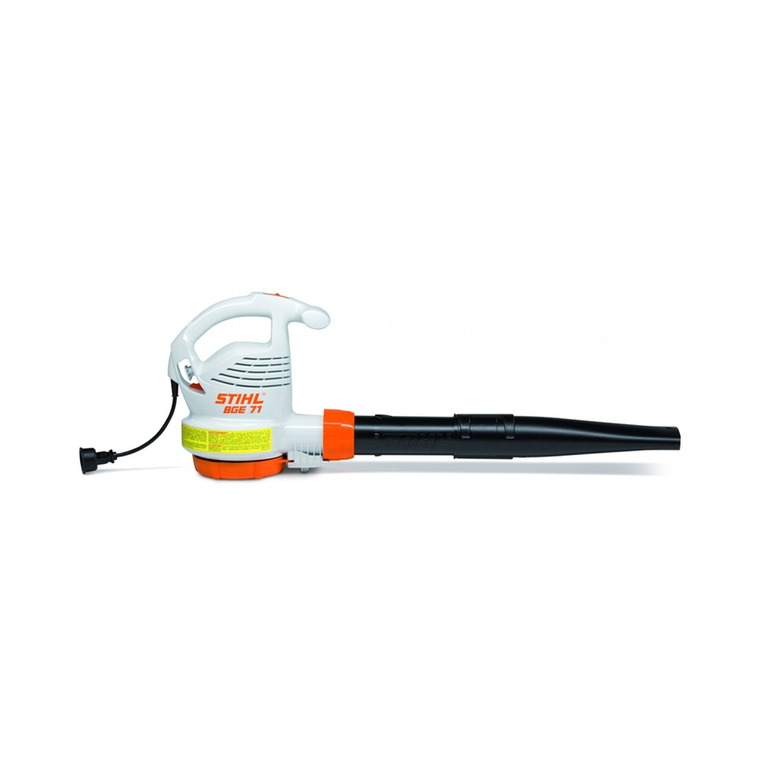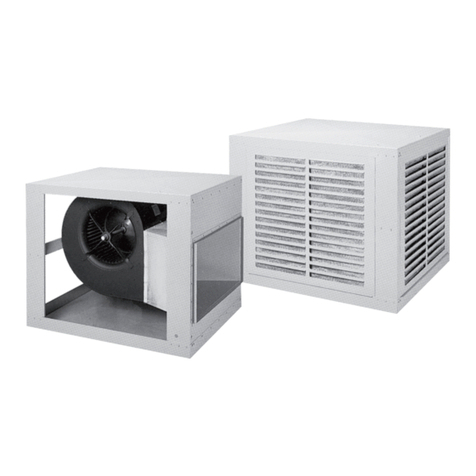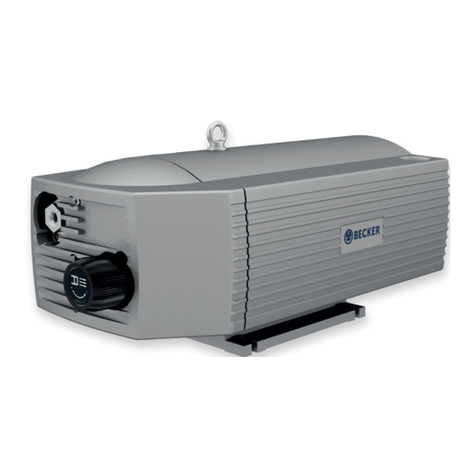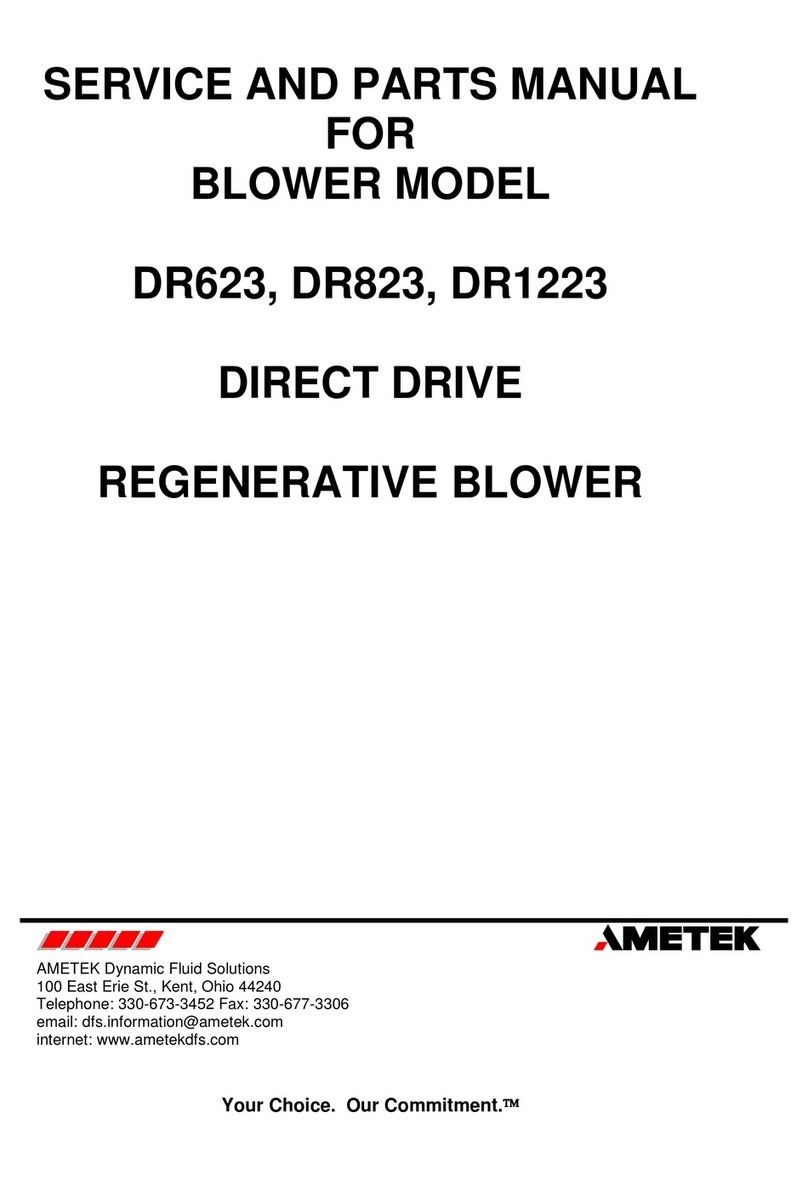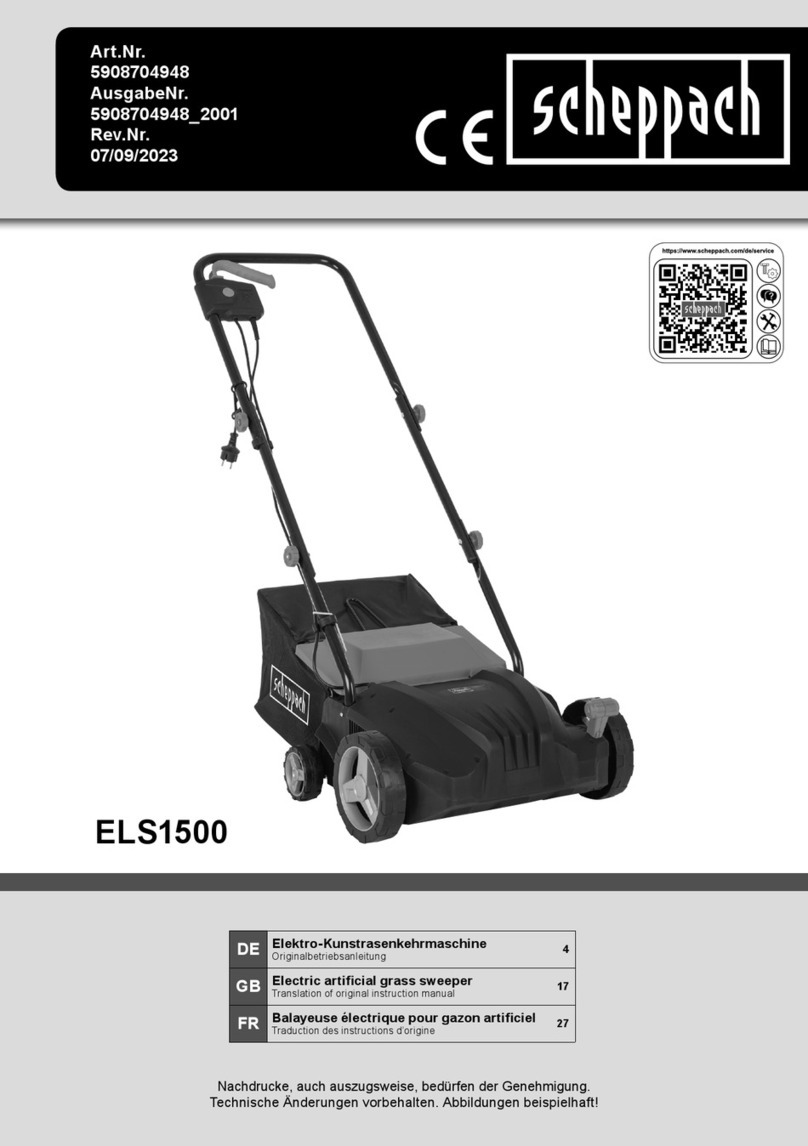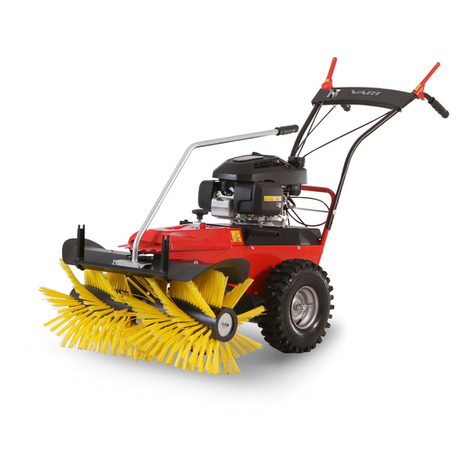JDW ZQ561 User manual

1
ZQ56105102018
18V Leaf Blower
Instruction Manual
Model Ref: ZQ561

01
INTRODUCTION
Thank you for choosing this Leaf Blower. This product is
manufactured to the highest standards of performance and
safety.
Before use, please read this manual carefully. It gives
important instructions about safety, use and maintenance of
your device.
Remove all packaging material. You may wish to keep
the packaging for future use or storage of your device.
Alternatively, dispose of accordingly.
Please note that the battery from this model is also
compatible with two of our other products:
- ZQ562 – Cordless Trimmer
- ZQ563 – Cordless Hedge Trimmer
CONTENTS
Introduction........................................................01
Important Safety Information ...........................02
Special Safety Instructions ..............................05
Product Overview..............................................07
Before First Use.................................................08
Starting The Machine ........................................08
Specication ......................................................10
Disposal Information ........................................11

02
IMPORTANT SAFETY INFORMATION
Intended Use
This power tool is intended to be used for leaves
blower.
Warning:
1. This appliance is not intended for use by persons
(including children) with reduced physical, sensory or mental
capabilities, or lack of experience and knowledge, unless
they have been given supervision or instruction concerning
use of the appliance by a person responsible for their safety.
2 Children should be supervised to ensure that they do not
play with the appliance.
3. Please do not try to run the appliance before assembly
vacuum tube and dust bag.
WARNING Read all safety warnings and all instructions.
Failure to follow the warnings and instructions may result in
electric shock, re and/or serious injury. Save all warnings
and instructions for future reference.
Training
- Read the instructions carefully. Be familiar with the controls
and the proper use of the machine.
- Never allow children to use the machine.
- Never allow people unfamiliar with these instructions to
use the machine. Local regulations may restrict the age of
the operator
- Never operate the machine while people, especially
children, or pets are nearby.
- The operator or user is responsible for accidents or
hazards occurring to other people or their property.

03
Preparation
- While operating the machine, always wear substantial
footwear and long trousers.
- Do not wear loose clothing or jewellery that can be drawn
into the air inlet. Keep long hair away from the air inlets.
- Wear protective goggles while operating
- To prevent dust irritation the wearing of a face mask is
recommended
- Never operate the machine with defective guards or
shields, or without safety devices, for example debris
collector in place
Operation
Disconnect the machine from the battery pack
- Whenever you leave the machine,
- Before clearing a blockage,
- Before checking, cleaning or working on the machine,
- if the machine starts to vibrate abnormally.
- Operate the machine only in daylight or in good articial
light.
- Do not overreach and keep your balance at all times.
- Always be sure of your footing on slopes.
- Walk, never run.
- Keep all cooling air inlets clear of debris.
- Never blow debris in the direction of bystanders.
- We recommend to operate the machine only at reasonable
hours – not early in the morning or late at night when people
might be disturbed.
- We recommend to use rakes and brooms to loosen debris
before blowing/vacuuming;
– We recommend to slightly dampen surfaces in dusty
conditions or use mister attachment;
– We recommend to use the full blower nozzle extension so
the air stream can work close to the ground

04
Maintenance and storage
– Keep all nuts, bolts and screws tight to be sure the machine
is in safe working condition.
– Replace worn or damaged parts.
– Use only genuine replacement parts and accessories
– Store the machine only in a dry place.
Recommendations
– Avoid using the machine in bad weather conditions
especially when there is a risk of lightning.
Residual Risks
Even when the tool is used as prescribed it is not possible to
eliminate all residual risk factors. The following hazards may
arise in connection with the tool’s construction and design:
1. Damage to lungs if an eective dust mask is not worn.
2. Damage to hearing if eective hearing protection is not
worn.
3. Health defects resulting from vibration emission if the
power tool is being used over longer period of time or not
adequately managed and properly maintained.
WARNING! This machine produces an electromagnetic eld
during operation. This eld may under some circumstances
interfere with active or passive medical implants. To reduce
the risk of serious or fatal injury, we recommend persons with
medical implants to consult their physician and the medical
implant manufacturer before operating this machine.

05
SPECIAL SAFETY INSTRUCTIONS
- Do not charge appliance in damp or wet locations.
- Do not use battery-operated appliance in rain.
- Remove or disconnect battery before servicing, cleaning or
removing material from the gardening appliance.
- Do not dispose of the battery in a re. The cell may
explode. Check with local codes for possible special disposal
instructions.
- Do not open or mutilate the battery. Released electrolyte is
corrosive and may cause damage to the eyes or skin. It may
be toxic if swallowed.
- Exercise care in handling batteries in order not to short the
battery with conducting materials such as rings, bracelets,
and keys. The battery or conductor may overheat and cause
burns.
- Charge only using the charger provided with the tool.
- Do not place outlet tubes near eyes or ears when operating.
- Do not cross gravel paths or place the tool on gravel while
the tool is switched on.
- Do not place any objects into the openings and moving
parts.
- Before removing the blow tube, always switch o the tool,
remove the battery and allow the tool to run down.
- Avoid dangerous environment. Do not use appliances in
damp or wet location.
- Keep children away. All visitors should be kept at a distance
from work area.
- Dress properly. Do not wear loose clothing or jewelry. They
can be caught in moving parts. Use of protective gloves and
substantial footwear is recommended when working outdoors.
Wear protective hair covering to contain long hair.

06
- Use right appliance. Do not use appliance for any job except
that for which it is intended.
- Do not force appliance. It will do the job better and with less
risk of injury at the rate for which it was designed.
- Do not overreach. Keep proper footing and balance at all
times.
- Stay alert. Watch what you are doing. Use common sense.
Do not operate appliance when you are tired.
- Store idle appliances indoors. When not in use, appliances
should be stored indoors in dry, and high or locked-up place,
out of reach of children.
- Check damaged parts. Before further use of the appliance,
a guard or other part that is damaged should be carefully
checked to determine that it will operate properly and perform
its intended function.
- Check for alignment of moving parts, binding or moving
parts, breakage of parts, mounting, and any other condition
that may aect its operation. A guard or other part that is
damaged should be properly repaired or replaced by an
authorized service center unless indicated elsewhere in this
manual.

07
SAFETY WARNINGS FOR CHARGERS AND
BATTERY
Battery
- Never attempt to open for any reason.
- Do not expose to water.
- Do not incinerate the battery pack even if it is severely
damaged or is completely worn out. The battery pack can
explode in a re.
- Do not store in locations where the temperature may exceed
40C.
- Do not leave the battery pack in the charger when the charging
is nished, otherwise battery leakage may occur.
- Charge only at room temperature.
- Charge only using the charger provided with the tool.
- Before charging, make sure that the battery is dry and clean.
- Use only the correct type of battery for the tool.
- When dispose of batteries follow the instructions given in the
section “protecting the environment”.
- Under extreme conditions, battery leakage may occur. When
you notice liquid on the battery, proceed as follows:
- Carefully wipe the liquid o using a cloth. Avoid skin contact.
In case of skin or eye contact, follow the instructions below.
- The battery uid, a 25-30% solution of potassium hydroxide,
can be harmful. In case of skin contact, immediately rinse with
water. - Neutralize with a mild acid such as lemon juice or
vinegar. In case of eye contact, rinse abundantly with clean water
for at least 10 minutes. Consult a physician.
NOTE: The batteries in your battery pack are the Lithium-Ion
type. Do not dispose of battery packs/batteries into household
waste, re or water. Battery packs/batteries should be collected,
recycled or disposed of in an environmental-friendly manner.

08
Chargers
- Longest life and best performance can be obtained if the battery
pack is charged when the air temperature is between 18-24C.
Do not charge the battery pack in a very low or very high air
temperature.
- The Charger’s plug must match the outlet. Never modify the plug
in any way. Unmodied plugs and matching outlets will reduce risk
of electric shock.
- Use your charger only to charge batteries of the type supplied
with your tool. Other batteries could burst, causing personal injury
and damage.
- Only 2 battery packs are allowed to be charged continuously in
order to prevent overheating of charger, necessary rest time is
required to let the charger cool down before further charging.
- When charging is nished, unplug the charger from mains socket
outlet and take away the battery pack from the charger, do not
leave the battery pack in the charger.
- Never carry the charger by its cord or pull the cord to disconnect
from the socket. Keep the cord away from heat, oil and sharp
edges.
- Never attempt to charge non-rechargeable batteries.
- The cord of charger is not changeable, do not continue to use if
the cord is damaged.
- Do not expose to water or rain, do not use in wet conditions.
- Do not open the charger.
- Do not probe the charger.
- The charger is intended for indoor use only.
- The charger and battery pack may become warm to touch while
charging. This is a normal condition, and does not indicate a
problem.

09
PRODUCT OVERVIEW
1. Blower Tube
2. Tube Release button
3. Handle
4. Main switch
5. Battery Pack

10
ASSEMBLY
Before assembling the Blower Tubes, be sure the Main switch
(4) is in ‘’O’’ O position.
Fit the Blower Tube to the motor housing as shown in Fig 2.
Check the Blower Tube is rmly secured.

11
OPERATION
WARNING! The charger and battery pack are specially
designed to work together so do not attempt to use any other
devices. Never insert or allow metallic objects into your charger
or battery pack connections because of an electrical failure and
hazard will occur.
You must charge once before use. The battery charger supplied
is matched to the Li-ion battery supplied with the machine. Do
not use another battery charger.
Charging Your Battery Pack
The battery needs to be charged before rst use and whenever
it fails to produce sucient power on jobs that were easily done
before. After several charge and discharge cycles, the battery
will attain full capacity. The battery may become warm while
charging; this is normal and does not indicate a problem.
Remove it from the tool and insert it into the charge station.
The battery pack will only t into the charger in one way. Do not
force. Be sure that battery is fully seated in the charger.
Read all of the instructions in the battery charger section of this
manual before attempting to charge the battery pack for your
tool.
These chargers require no adjustment and are designed to
be as easy as possible to operate. Simply place your battery
pack into the receptacle of a plugged in charger and it will
automatically charge the pack.

12
NOTE! It can not be charged if charging the battery immediately
after using the machine. The battery pack should be cooling for
a period of time. The LED from green to red means it can be
charged.
- The battery pack will be fully charged in about 4 hours. And the
LED lights green again to tell you that the battery pack is fully
charged.
To Remove or Install Battery Pack
- Always move the Main switch to the OFF position before insertion
or removal of the battery pack.
- To remove the battery pack, withdraw it from the tool while pulling
the Battery Release Button down.
- To insert the battery pack, groove along the handle and insert in
the full position, until the Battery Release Button bounce back to
normal position again.
Starting/Stopping Leaf Blower
Starting:
Move the Main switch to the “I” ON position.
Stopping:
Move the Main switch to the “O” OFF position.
Using The Leaf Blower
The blower is intended for residential use only. Use the blower
outdoors to move debris from hard surfaces. This blower is not
designed to clear leaves from large grassy areas, or move wet,
heavy debris.
User Tips
- Hold the blow tube approx. 15-20 cm above the ground when
operating the tool. Use a sweeping motion from side to side.
Advance slowly keeping the accumulated debris/leaves in front of
you.

13
Caution!
- After blowing the debris/leaves into a pile, it is easy to dispose of
the pile.
- Do not blow hard objects such as nails, bolts, or rocks.
- Do not operate the blower near bystanders or pets.
- Use extra care when cleaning debris from stairs or other tight
areas.
- Wear safety goggles or other suitable eye protection, long pants,
and shoes.
MAINTENANCE
WARNING! Always switch o the tool and remove the battery from
the tool before performing any maintenance.
Your tool has been designed to operate over a long period of time
with a minimum of maintenance. Continuous satisfactory operation
depends upon proper tool care and regular cleaning. Your charger
does require any maintenance apart from regular cleaning.
- Before performing any maintenance on the tool, remove the
battery from the tool. Unplug the charger before cleaning it.
- Regularly clean the ventilation slots in your tool and charger
using a soft brush or dry cloth.
- Regularly clean the motor housing using a damp cloth. Do not
use any abrasive or solvent-based cleaner.

14
SPECIFICATION
Rated Voltage DC 18V
A-weighted sound pressure lev-
el LpA 73.0dB(A)
Uncertainty KpA 3 dB(A)
A-weighted sound power level
LWA 85.9 dB(A)
Uncertainty KWA 3 dB(A)
- Guaranteed sound power
level(in accordance with
2000/14/EC)
98 dB(A)
Declaration of the vibration
emission according to EN ISO
8662-1
0.658 m/s2
Uncertainty 1.5 m/s2
Sound pressure level
Uncertainty KpA= 3.0 dB 75 dB(A)
Battery Charging Time Approx. 4 Hours
Battery Capacity 1500 mAh
Battery Type Lithium-Ion
STORAGE
If storing Blower for more than 30 days, follow steps below.
- Remove battery from Blower.
- Charge battery completely.
- When battery is completely charged, remove from charger.
IMPORTANT: To prolong battery life, avoid leaving battery on
charger for extended periods of time (over 30 days without use).
Store Blower and battery
- in a high or locked place, out of children’s reach.
- in a dry place.

15
DISPOSAL INFORMATION
IMPORTANT INFORMATION FOR CORRECT DISPOSAL
OF THE APPLIANCE IN ACCORDANCE WITH EC
DIRECTIVE 2002/96/EC
At the end of its working life, the Pressure Washer must NOT
be disposed of as urban waste.
It must be taken to a special local authority dierentiated
waste collection centre or to a dealer providing this service.
Disposing of a household appliance separately avoids
possible negative consequences for the environment and
health deriving from inappropriate disposal and enables the
constituent materials to be recovered to obtain signicant
savings in energy and resources. As a reminder of the need
to dispose of household appliances separately, the product is
marked with a crossed-out wheeled dustbin.

JD Williams Ltd.
Manchester, UK, M60 6ES
M606ESO1
Table of contents
Other JDW Blower manuals
